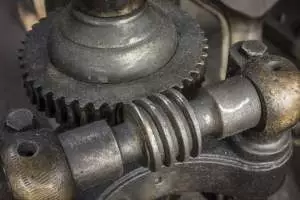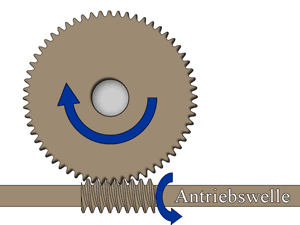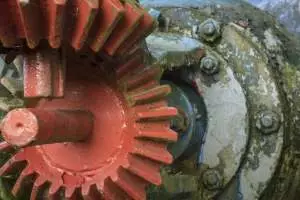The choice between Worm gear units and bevel gear units has a major influence on efficiency and operating costs. In this article we would like to give you the most important advantages of worm and bevel gear units so that you can determine which one is the most suitable for your application. If you still have any questions, please do not hesitate to contact us: Contact form
Further information on worm and bevel gear units.
Frequent applications of angular gearboxes
Worm and bevel gears are often used to transmit motion at right angles or when other properties are required.
- Conveyor belts
- Crane
- Elevators
- Mixer
- Beverage industry
- Many other applications
Worm gear
A worm gear unit consists of two parts: a worm shaft with worm gears and a worm wheel. The two components are often made of two different materials (steel worm shaft and bronze worm wheel). Worm gears transmit the movement force at right angles via a sliding effect instead of a rolling movement.
Advantages
- Worm gears are mainly used when a large gear ratio is required. With a worm gear unit, a large overall ratio can be achieved with only a few stages. This means that a smaller, less expensive gearbox can be used.
- The highest ratio of a worm gear unit is about 100:1.
- High self-locking due to the sliding effect of the worm shaft makes an additional brake either obsolete or it is only necessary to install a small, less expensive brake. However, this property depends on the angle of inclination and the friction angle.
- More favourable than bevel gear
- Hollow shaft possible
Disadvantages
- The sliding contact of the gears causes strong friction, which results:
- one High operating temperature
- one Low efficiency
- High wear on the worm wheel, which is mostly made of bronze. (Only through bronze production a relative efficiency is possible. The friction would be much higher with steel on steel.)
Bevel gears
4 types of bevel gears
- Spiral
- Straight
- Cerol
- Skew Tooth
Bevel gear sets are composed of two parts, the bevel pinion and bevel gear, which transmit movements at right angles.
Bevel gears use angular gear teeth. As the gears rotate, the entire tooth width of the interlocking teeth is used to transmit the force. In addition, several teeth interlock at the same time. This results in the following advantages.
Advantages
- Quiet Operating noise (Quiet operation is particularly advantageous in environments such as theatres or airports.)
- Increased torque capacity compared to worm gears of the same size.
- High efficiency (rolling of bevel gears is very efficient compared to the sliding effect of worm gears (98.5%). The metal bevel gear teeth never come into direct contact with an oil film.)
- Hollow shaft possible
Disadvantages
- High costs.
- Bevel gears are manufactured in pairs. For maintenance and repair, both gears must be replaced.
- In order to achieve high efficiency, bevel gear sets must be positioned exactly, so the shafts must be adjusted very precisely.
- Limited translation range. Maximum ratio of 6:1 per bevel gear set. Spur gear stages are necessary in order to achieve a higher overall gear ratio.
- Bevel gears are not recommended for high-speed reduction. At high speed, a bevel gear unit generates noise.
Further information
Do you have any questions?
Please contact us: Contact form
Rating
You liked this article? We are looking forward to your feedback or comments.
Comments
We are looking forward to your feedback, suggestions, criticism, wishes for topics (of course also via contact form).


